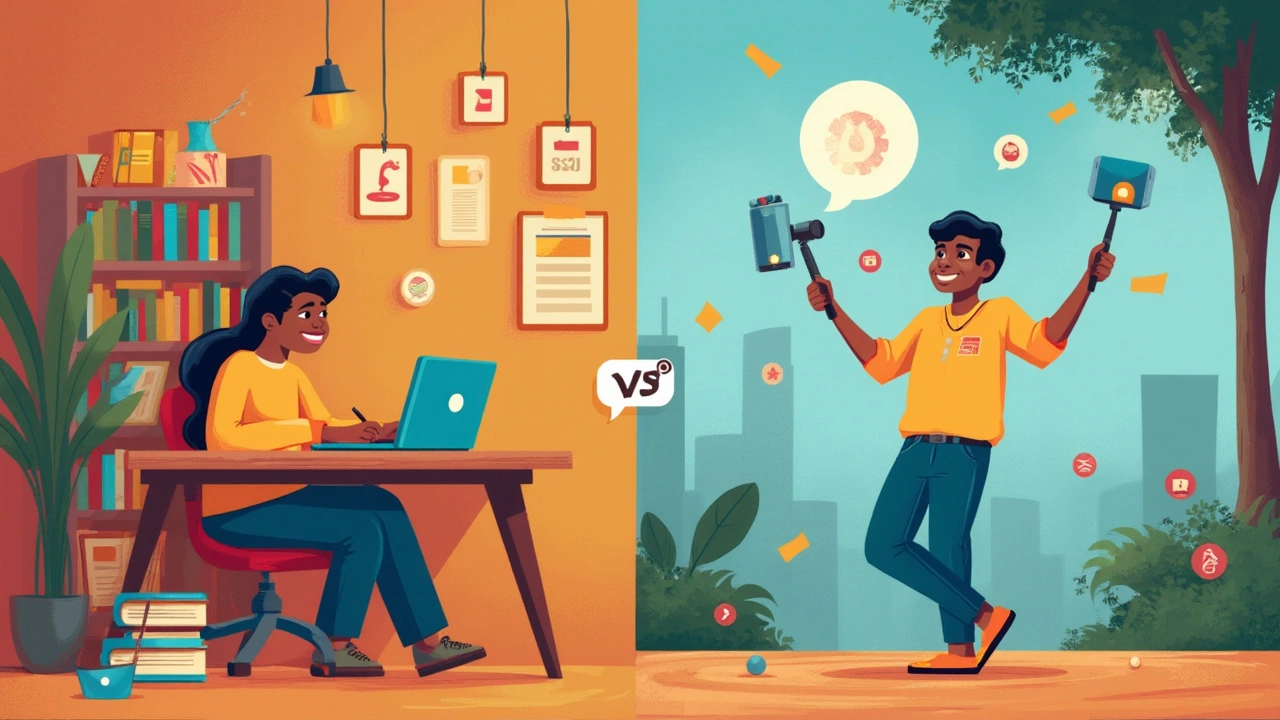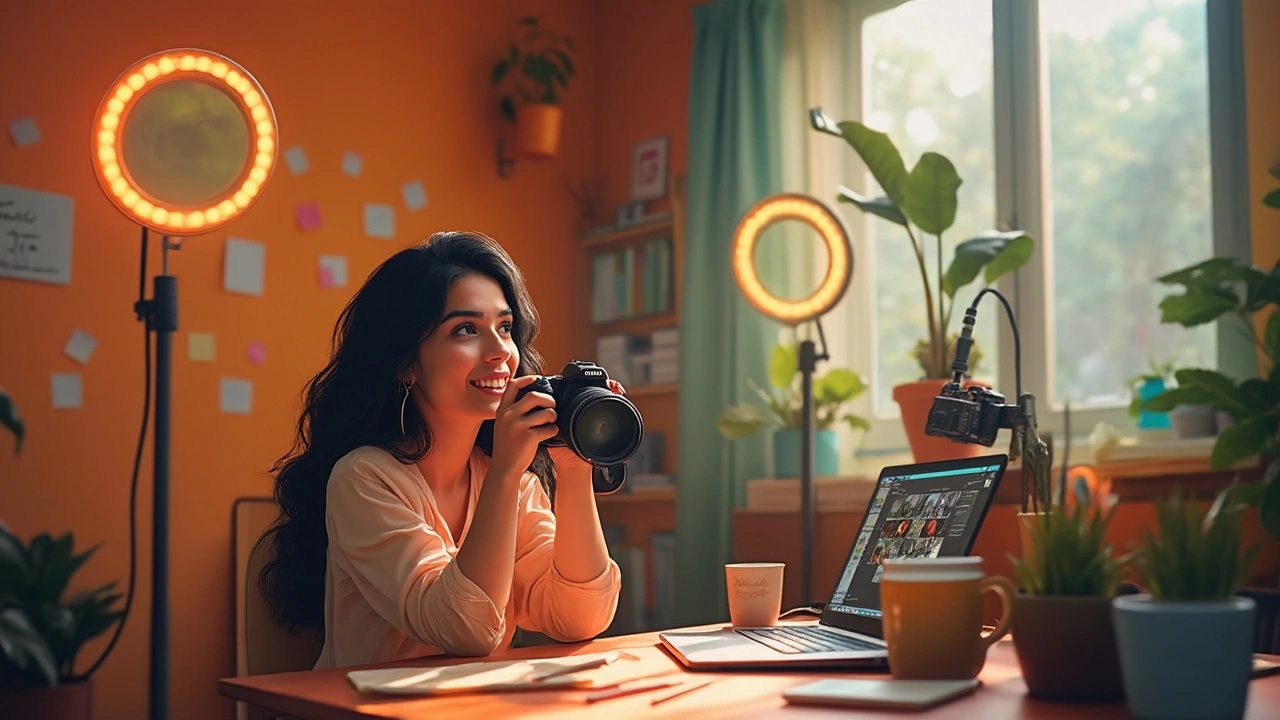Ever heard the term 'vogger' and wondered if it's some tech thing or a spelling mistake? It's actually the unofficial nickname for a video blogger—someone who shares their thoughts, advice, or stories through videos instead of old-school text.
Video content grabs attention in ways written words just can't. People want to see expressions, hear voices, and get real human vibes. That’s why voggers blow up on YouTube, TikTok, and Instagram Reels—they connect on a level that blogging often misses. Plus, algorithms love videos. If you want your content to reach wider audiences fast, vogging is the ticket.
Starting out as a vogger doesn’t mean you need a fancy DSLR or a Hollywood-style studio. A decent phone camera, a quiet spot, good lighting, and a splash of personality often do the trick. Most successful voggers started with the basics and found their groove over time. Your awkward first few videos? Don’t sweat it—everyone cringes at their early stuff, but consistency pays off.
- What the Heck Is a Vogger?
- Voggers vs Bloggers: The Real Differences
- Why Video? The Science Behind the Trend
- Tools and Gear to Get You Vogging
- Making It Work: Tips for Starting as a Vogger
What the Heck Is a Vogger?
A 'vogger' is someone who blends the classic idea of blogging with the power of video. Instead of writing pages of text, a vogger records themselves talking, showing, or even acting out their content. It’s like a personal TV show people can watch on their phones, anytime. This approach exploded in the 2010s and now dominates everything from how-to tips to gaming, travel stories, and even daily diaries.
The main thing that separates a vogger from a regular blogger is, you guessed it, the video format. Voggers throw in their personalities, facial expressions, and reactions—stuff that’s hard to put into words. Platforms like YouTube, TikTok, and Instagram Reels have fueled this wave, and some even say vogging is the new blogging. You might already follow a few voggers even if you don’t realize it—think of famous YouTubers or those funny TikTokers you scroll through after work.
Here’s a snapshot showing how video content is changing the game:
| Year | % of Internet Traffic from Video |
|---|---|
| 2015 | 66% |
| 2020 | 80% |
| 2024 | 82% |
That’s a massive jump, and it’s only getting bigger. More people are choosing to watch rather than read. Brands and regular folks are cashing in, reaching huge crowds with their stories, reviews, and tutorials in video form.
So, the next time you see someone talking straight into their phone or camera about travel tips, cooking hacks, or just life stuff—they’re probably a vogger. And if you’re thinking about sharing your own story, becoming a vogger could be the best move in 2025.
Voggers vs Bloggers: The Real Differences
Let’s get real about how voggers and classic bloggers are not the same breed. Traditional bloggers stick to written content—think text-heavy articles, how-to guides, and maybe some pictures or graphics. Voggers, meanwhile, are all about video. They deliver their message to the camera, letting facial expressions, tone, and energy do half the work.
Here's a quick comparison that makes things crystal clear:
| Aspect | Bloggers | Voggers |
|---|---|---|
| Main Platform | WordPress, Medium, Substack | YouTube, TikTok, Instagram Reels |
| Content Format | Text (with images/links) | Video (with talking, editing, effects) |
| Audience Interaction | Comments and newsletters | Live streams, video replies, instant chat |
| Skills Needed | Writing, basic SEO, formatting | Public speaking, filming, editing video, thumbnail design |
| Average Consumption Time | 2–7 minutes per article | 30 seconds–15 minutes per video |
One big thing? Video is naturally more personal. When you vlog, your quirks, tone, and sense of humor come through. That helps build trust fast—studies show viewers are 65% more likely to remember info from a video versus text.
Monetization works a bit differently, too. Bloggers usually make cash with ads, affiliate links, and sponsored posts. Voggers, though, can stack up YouTube ad revenue, paid partnerships, super chats during live streams, and even fan memberships.
Want to dip your toes in? Most big creators today cross over—bloggers add videos to boost their posts, and voggers often turn their talking points into short written tips for SEO. The lines keep blurring, but each has its unique vibes and tools. Figure out what feels natural, and double down on your strengths.

Why Video? The Science Behind the Trend
You probably notice everyone’s glued to short videos these days. That’s not by accident—there’s real science behind why video blogging is exploding and why voggers are killing it right now. The human brain loves visuals. In fact, studies show people process visuals about 60,000 times faster than text. That means your message hits home way quicker if you’re talking to a camera instead of typing up a long blog post.
People just remember videos better. After watching a video, viewers retain 95% of the message compared to just 10% when reading text. Now, think about those numbers for your next product review or how-to guide. If you’re answering questions or showing something tricky—say, how to bake bread or train a stubborn dog like Max—video simply works better. Plus, you get to add your own twist with your voice, face, and personality. That makes folks trust you more.
Another massive reason? Social platforms totally push video content. TikTok, YouTube, and Instagram Reels all want you to watch more clips, so their algorithms boost video blogging way higher than plain text posts. Your stuff gets seen by more eyeballs, and growth happens faster. Even on Facebook, video posts get 59% more engagement on average.
| Content Format | Average Retention Rate | Engagement Bump |
|---|---|---|
| Text (Blogging) | 10% | Low |
| Video (Vogging) | 95% | +59% |
Here’s what gives videos a leg up:
- Emotion: Seeing someone’s face feels way more personal than reading words, building real connections.
- Simplicity: You can show and explain at the same time—super helpful for tutorials or opinions.
- Shareability: People are way more likely to share funny, cool, or helpful videos.
The bottom line is, if you want to reach people in 2025, video isn’t just helpful. It’s basically a must.
Tools and Gear to Get You Vogging
Getting started as a vogger is way less complicated than people imagine. You don’t need fancy studio equipment or millions in the bank. What matters more is clear audio, steady video, and basic editing skills.
The camera on your smartphone works fine for 90% of new voggers. Modern phones shoot in Full HD or even 4K, so don’t rush out for professional gear right away. If you're filming with your phone, grab a small tripod or flexible stand (like a Gorillapod) to keep things steady. Shaky footage is tough to watch, and viewers bail pretty fast if things start moving too much.
Audio often trips people up. The mic on your phone is okay but picks up background noise and echoes. Consider plugging in a cheap lavalier mic. You can grab a decent one online for under $30, and it instantly improves sound quality. If you’re recording outside—or in a room with a loud dog like my Max—audio quality makes a world of difference.
Good lighting is underrated. Look for natural daylight near a window or grab an inexpensive ring light. Weird shadows make videos look amateur. For $20-$40, a simple ring light setup boosts video quality way more than an expensive camera upgrade does in the beginning.
Editing is where you add polish. Free apps like CapCut or InShot on mobile, or basic desktop programs like DaVinci Resolve, let you trim awkward pauses, add captions, and drop in music. Start with the free versions—figure out what you like before splurging on pro tools.
Here’s a quick comparison to give you an idea of what basic vogging gear costs right now:
| Gear | Example | Average Price (USD) |
|---|---|---|
| Smartphone (1080p/4K camera) | iPhone 13, Samsung S22 | $400-600 |
| Lavalier Microphone | Boya BY-M1, Rode SmartLav+ | $15-40 |
| Tripod / Stand | Gorillapod, UBeesize tripod | $20-30 |
| Ring Light | Neewer 10" Ring Light | $25-40 |
| Editing App | CapCut, InShot, iMovie | Free - $10/month |
Don’t let any lack of gear stop you. Plenty of viral voggers started in their bedrooms with a phone balanced on a pile of books. Upgrade as you go, not before you start. Consistency and good content matter way more than the size of your lighting rig or mic brand.

Making It Work: Tips for Starting as a Vogger
If you want to become a vogger, you don’t need to learn a bunch of complicated stuff to get rolling. Here’s what actually works when you’re new and want to build a solid channel without losing your mind or money along the way.
Start simple. Your phone’s camera is probably good enough for early videos. Good lighting matters way more than fancy gear—stand near a window during daytime or use a cheap ring light. Clean audio is also a must, so use wired earbuds with a mic or grab a clip-on microphone for around $20. That’s your secret to not sounding like you’re talking from a cave.
Plan out your videos, but don’t script every line. People respond to natural talk, not robots reading notes. Use a few bullet points to hit the main points and let your personality show. If you mess up, just take another shot—editing cuts out all the awkward bits (lots of free or cheap apps out there, like CapCut or iMovie).
Post regularly. Consistency wins, even if you start with one video a week. Audiences come back for creators who show up. Pick a schedule, even if it’s every Saturday morning, and stick to it as much as you can.
It’s normal to feel awkward on camera at first; almost every big creator was weird about it in the beginning. Try practicing by recording short clips just for yourself. Watch them back—not for self-critique, but to see where you come off most natural. My dog Max always wanders into my shots, which usually gets a better laugh than anything I plan. People love a little real life.
Track your progress. Platforms like YouTube and TikTok give solid data about what works. Here’s a quick look at what the analytics may show after a month if you post weekly:
| Metric | Average for New Voggers (Month 1) |
|---|---|
| Views per Video | 200-700 |
| Subscribers/Follows Gained | 10-50 |
| Average Watch Time | 35-90 seconds |
| Most Popular Topic | Personal Stories |
Networking helps too. Comment on other voggers’ videos, join community chats, and be supportive. People remember who’s active and helpful in the space. Don’t DM people asking for shoutouts—just be cool, and opportunities come naturally.
Finally, focus on making each video a little better than the last. You’ll get faster, more confident, and viewers will notice the growth. Stumble, laugh, and don’t chase perfection. The best voggers feel like someone you already know.
